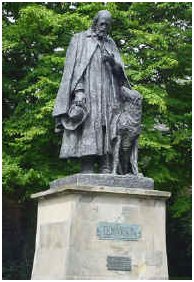Alfred, Lord Tennyson died on 6 October 1892. A few years later his friend, George Frederick Watts began work on a memorial statue of Tennyson. Watts was in his mid-eighties when he began the work in 1898 and was 86 years old when he finished it in 1903, the year before his own death in 1904.

The statue stands at the Lincoln Cathedral. Unfortunately, Watts did not get to see his work in place; the statue was installed at the Cathedral in 1905. In the above picture of the statue you can see that Tennyson is depicted alongside his dog, Karenina, and he is looking down at his hand. In his hand is a small flower. Watts was inspired by Tennyson’s poem ‘Flower in the crannied wall’ (published 1869).
Flower in the crannied wall,
I pluck you out of the crannies,
I hold you here, root and all, in my hand,
Little flower—but if I could understand
What you are, root and all, and all in all,
I should know what God and man is.
In this short poem Tennyson meditates on how he can understand God by understanding nature. If he could understand the flower ‘all in all’ he would understand its nature and therefore the nature of its creator. Watts has represented Tennyson in just as I would imagine he looked when he wrote this poem.
Watts’s depiction of Tennyson’s pensive facial expression in this statue is in keeping with the tone of the poem. The addition of Karenina, though some argue she was added to give support to the massive statue, further emphasises Tennyson’s closeness to nature. The dog is looking up at him expectantly as though she is interested in or concerned about what he is doing.
In this statue Watts manages to capture Tennyson’s humanity more so that he would have had he chosen a more formal pose. He was able to concentrate what he knew of the man in this final tribute to the great poet.
Over the next few weeks I’ll be examining the friendship between Tennyson and Watts. In these blogs I will look at Watts’s portraits of Tennyson and at what we know of Watts’s time on the Isle of Wight. He lived in the Briary so he could be close to his friends, the Tennysons and Julia Margaret Cameron. At the National Portrait Gallery website (https://www.npg.org.uk) you’ll find Watts’s 1863-64 portrait of Tennyson along with portraits of the poet by many other artists, including several by Julia Margaret Cameron. Which portrait(s) of Tennyson do you find most striking?